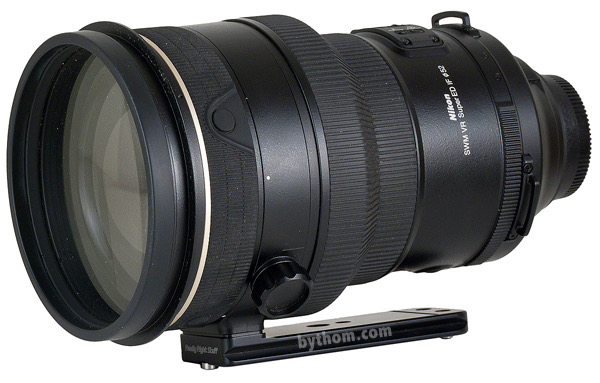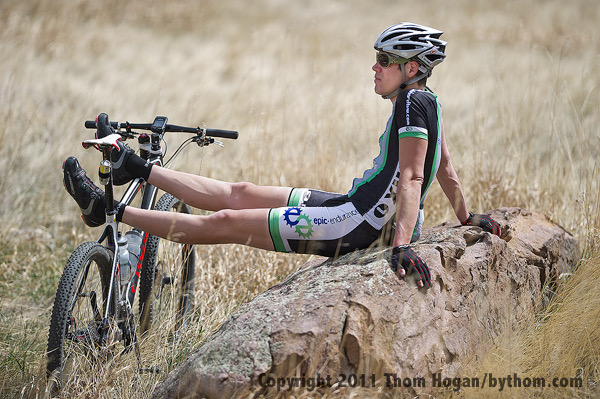"Fat people are adorable." —Jackie Gleason

Note: this review is of the first version of the AF-S 200mm f/2G. Nikon has since produced a revised version with a newer VR system and Nano coated elements in it. I've had a chance to compare the two side by side, and optically they appear identical to me in real world shooting, though I'm sure that if I work hard enough I might find some small differences in very specific situations. I mention this because B&H and others still have the older version available for US$1000 less.
What is it?
The Nikkor 200mm f/2G is affectionately known as the "fat boy." At 8" long and nearly 5" in diameter, this lens has a short, stout profile. To put that in perspective, this lens is about the same length as the 70-200mm f/2.8, but tips the scales at almost 6.5 pounds (2900g). Lifting this lens is a bit like lifting a small hand weight in the gym. The short and even wider lens HK-31 hood doesn't help negate the fat profile the lens generates.
The optical formula is 13 elements in 8 lens groups. Three of them are Super ED (Extra-low Dispersion) elements that help keep chromatic aberrations at bay. Curiously, there is no Nano coating, though the lens is SIC (super integrated coating). (Nikon has since added Nano coating.)
The published MTF chart for this lens is considerably poorer than some of the other exotic lenses, as it shows a steady decline past 10mm off center. We'll talk more about that in the performance section, below.
The lens covers both DX and FX formats, presenting a 8° degree angle of view (diagonally) on DX, 12°20' on FX. Close focus is 6.2 feet (1.9m), presenting a maximum magnification of 1:8.3. VR features the usual Normal/Active settings; Nikon claims a three stop improvement over hand holding (four stops on the newer model, which has Tripod/Normal settings). A rotating tripod collar with short, removable handle is included, as well as a 52mm drop-in filter cover right at the very back of the lens. As with all Nikon drop-in filters, the supplied plain filter is part of the optical formula; using a filter holder without glass is a slight no-no. The lens has a focus scale with FX DOF markings for f/22 (in other words, nothing you'll ever use). As with most high-end Nikkors, there are 9 aperture blades. There's dust/moisture protection built in.
The lens came in a soft shell exotic Nikkor case for US$5099 (newer version US$5699). Nikon's page for the lens is here.
Source of the reviewed lens: purchased
How's it Handle?
I hope you've been lifting weights. A D5+200mm f/2 is nearly nine pounds in a pretty small package. That said, there's something different in getting your hand under the 200mm f/2 compared to the longer exotic lenses. Yes, you can hand-hold this lens if you need to. It's all about weight balance. You'll have a hand underneath this lens (usually with your elbow tucked against your rib cage for leverage), and the center of gravity is very compact, so you don't feel like you're fighting a tipping battle, you just have to hold the lens.
Curiously, Nikon's standard tripod mount on this lens seems to have less slop than those on the 200-400mm, 400mm, and 500mm I tested, despite being basically the same design. Still, make sure you lock it down tightly. The foot can't be used as a handle: the mount is too close to the focus ring. Also, the foot is backward facing (towards the camera).
The focus ring is wide and easy to find. The focus buttons (lock/recall/AF-On), however, are far forward of the focus ring and near the front of the lens. The distance and position make it difficult to use them and fine tune focus. I end up cupping the lens near the front and using my palm to nudge the focus ring, which is not optimal. I don't have a lot of luck with extending a finger out from a hand position at the focus ring to find the focus button while hand holding. I can't do three things at once (stabilize the lens, rotate the lens ring, and reach the focus button). I think Nikon needs to rethink these buttons and their position on this lens.
Personally, I dislike the rotating VR on/off switch. While easy enough to find at the back of the lens, for some reason this design has me missing the VR setting I really want to use more often than the plain old switch does. Part of that may be orientation. If you orient so the focus scale is up, the VR switch is off to the right just enough that you don't see it looking down at the lens. Of course, if you're shooting at eye-level on a tripod, you wouldn't look down at the focus scale without getting on your tip-toes, but the VR switch is not exactly on the side, either. It's just a position that doesn't fall naturally into my view, so I sometimes don't notice what I'm shooting at; I have to make a conscious effort to remember to check VR status, especially since the Active/Normal switch is nearly 90 degrees around the lens from the On/Off indicator. Hello, Nikon? Why isn't VR status reported on the camera somewhere?
We've got five switches on the opposite side of the lens (one controlling type of VR). The lens doesn't have the new A/M and M/A choice (which allow you to pick how manual override happens versus autofocus), so you're stuck with the old M/A. That's okay, but since this is a hand-holdable lens, I would have liked the A/M choice, too. The most useful of the five switches is the focus limiter, which allows you to restrict the lens to 5m to infinity. The final two buttons are mostly to do with the focus buttons at the front of the lens. You can set and recall a fixed focus distance (an undervalued feature but one that's currently tough to remember how to use most effectively in the field). Or you can have the button provide AF-On or AF Lock. You can also have the lens beep confirmations to you. Put another way, the 200mm lens has a number of subtle customizations you can make to how it operates, and those changes can impact the speed of operation and/or image quality in subtle ways, too. Take the time to study the top four buttons carefully and figure out how they interact with your shooting.
The lens hood for the 200mm is a very light, but extremely vulnerable to bending out of round. I can't seem to travel without having to roll it back into proper shape. As usual, Nikon provides their hangman's hood instead of a proper lens cap. I use a shorter, more flexible Lens Coat cap in its place. Rounding out the features of the lens are two shoulder strap hooks (relatively close together) for those of you who want to sling the lens old style (new style would be using a Black Rapid strap hooked to an Arca Swiss foot).
The 200mm is probably the heaviest lens I ever attempt to shoot with hand held with any regularity.
How's it Perform?
The MTF charts initially scared me off this lens. What I'd expect on an FX body is poor corner performance and declining performance towards the edge. But let's check that out in practice. First, the full hand held frame at f/2.2 (not exactly sure why I was at f/2.2 and not f/2, but I was obviously trying to pull the biker off the background with a fast aperture):

Now let's go over towards the left edge and see what's written on the bike seat post:

No attempts to pull out detail via contrast or sharpening here, that's a 100% crop right out of the camera. Yes, it's a tad softer than the center, but that's likely from being just off the focus plane as much as it is from lack of acuity in the lens. I've actually been very pleased with the edge to edge performance of the lens on FX bodies. Yes, when I pixel peep I can see a difference at the corners, but in actual shooting I've not really found that it makes for a meaningful issue. Center of the lens is sharp wide open, and that extends far enough towards the edges for me. I see no chromatic aberration issues, either (that's no as in "none"). One point: the lens is a little better at f/2.8 and f/4 than f/2, which is unusual for the exotics (they usually are optimized for wide open performance). By "little" I mean little. But enough that if you shoot a high-contrast scene you'll see a little less contrast at f/2. So the MTF charts don't lie, after all, and a MTF at f/4 might tell you something different, basically that the center is now sharper than the corners (though the corners are still quite good). If you want to see some more results from the lens, look at the contrast charts in my D3x review.
You'll find a very small amount of pin cushion distortion. On DX it's not enough to bother correcting, on FX you might want to pull it in a bit with software correction. Vignetting is also well controlled. FX users will see less than a stop at the corners wide open, and DX users maybe a third-of-a-stop. By f/2.8 vignetting is well under control and neglible.
Focus is very fast and spot-on reliable on the high-end bodies. On low-end bodies this lens will make for a very front-heavy situation. Focus performance is still good on them, but putting a US$5000 lens on a US$500 body seems a bit odd.
I'm quite pleased with all the results I've shot with this lens, even with teleconverters. With the TC-14E on and stopped down, it's mighty close in performance to the venerable 300mm f/2.8, and still highly usable wide open. The TC-17E and TC-20E III are also very usable on the lens. It isn't far behind the 200-400mm f/4 with the TC-20E III stopped down a stop. But I'd rather have the 400mm f/2.8, by far: no other 400mm option Nikon currently has matches it.
Given the teleconverter friendliness of the lens, I don't feel any real need to own a 300mm f/2.8. My "D3s/D3x kit" consists of the 14-24mm, 24-70mm, 70-200mm, 200mm, 400mm, and the teleconverters. There are times when that extra stop at 200mm is very useful, and I don't feel like I'm really giving anything up by not going with the 300mm f/2.8 instead. I can just barely fit that complete kit into one of the larger ThinkTank Airport bags, and it pretty much covers anything I really need to do. The only lenses I ever seem to supplement that kit with are the f/1.4 primes, the PC-E lenses, or a macro lens, but those are more situational lenses for me--I'm usually shooting a particular subject and have cut down my kit to just what I need.
Final Word
The 200mm f/2 isn't for everyone. First, it's an expensive lens. Second, it's a brick-and-a-half in terms of weight. Third, its large diameter--especially with hood reversed on the lens--makes it not small bag friendly. But it's an exceptional performer, and 200mm at f/2 is extremely useful for indoor or night sports. I've never been dissatisfied with the results I've gotten from this lens, and other than the workout I get from lifting it (hint: use a monopod), I always happy to pull it out of the bag.
Recommended (2011 to present)
Support this site by purchasing from this advertiser:
